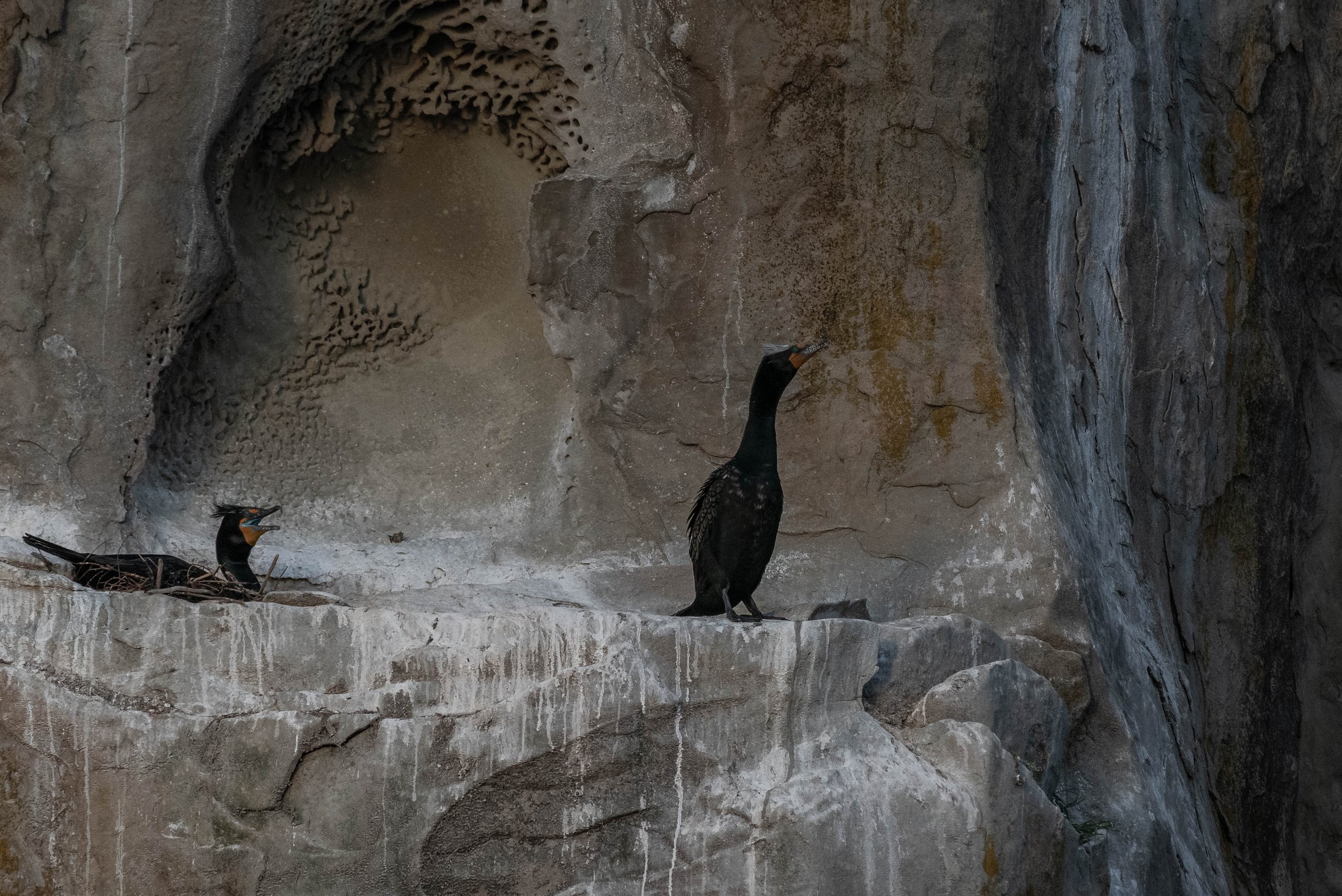April 26, 2025 - Two different orca encounters!
While our staff always have the wind in their sails, wind in the Strait is another matter entirely!
After cancelling the morning tour due to gusty conditions, we were more than ready to head out this afternoon. Our two boats set off from the harbour and ventured into the Strait of Georgia, fingers crossed for smooth sailing! We had a report of a pod of orcas across the pond near Vancouver, and we weren’t going to let a few waves stand in our way.
We found our small pod off the coast of West Vancouver, just south of Horseshoe Bay. This pod includes:
T124D Field ♀ (1996)
T124D1 Salish II (2014)
T124D3 (2022)
T124D4 (2024)
This is an especially wonderful family to observe because Field currently has two young calves with her! As mammals, these little calves rely on their mother's nutrient-rich milk to survive until they are weaned at around two years old. Orcas have an incredibly long gestation period of 15–18 months, meaning that Field was still nursing her first calf while pregnant with her second. What a supermom!
This young family was a joy to watch, with both youngsters easily keeping up with mom and older sibling Salish. Because Field has two young calves, she’ll be busy teaching them how to hunt and participate in the family dynamic. While orcas are fast and efficient hunters, when calves are present, the group often slows down and extends the hunt. This gives the youngest members time to learn essential survival skills, like stalking, chasing prey, and cooperating with others.
This is especially important for the three-year-old calf, T124D3, who now needs to keep pace with the older pod members since they are weaned. Considering that almost half of all orca calves don’t survive their first year, this youngster is doing remarkably well so far!
Take a peek at the photos below. See those scratches on the whales’ skin? These are called rake marks and can be caused by a few different things, most often during social play between whales. However, they can also be signs of aggression, especially between males. Sometimes, they’re the result of defensive behaviour from feisty sea lions, which have surprisingly sharp claws on their front flippers!
After following this small pod along the coast, we let them continue their journey and carried on with ours.
On our long trek back toward home, we came across a familiar sight near Gabriola Island—more orcas! This time, the large dorsal fins indicated adult males were present. We quickly recognized them as the T019s:
T019 Nootka ♀ (~1965)
T019B Galiano ♂ (1995)
T019C Spouter ♂ (2001)
These three are a familiar sight around Nanaimo, but we’re always thrilled to see them. This group once included four whales, but T018 Esperanza has been missing for nearly a year. While unconfirmed, we suspect she may have passed away, as she was quite old, born around 1955. Though female orcas can live into their 80s, most don’t reach that age. Males typically have a shorter average lifespan of just 30–40 years. All the members of this pod are aging, and we cherish every encounter with them.
The two males are easy to tell apart: Galiano’s dorsal fin has a distinct bend, while Spouter’s has a wavy trailing edge. We didn’t get to spend long with them, as we found them near the end of the trip, but it was a lovely sighting all the same.
Finally, we returned to Nanaimo after a day full of wildlife and whales! Onboard Marine Naturalists Aly Kohlman and Holly Archer captured some fantastic photos throughout the day, which you can check out below!
T124D1 Salish II surfacing just in front of the youngest, T124D4. Photo by Aly Kohlman.
T124D3 surfacing in the waves. Photo by Aly Kohlman.
T124D1 Salish Sea in front of a beautiful steep shoreline. Photo by Aly Kohlman.
T124D3 surfacing ahead of their mother, T124D Field. Photo by Aly Kohlman.
T124D3 creating a wave as they surface. Photo by Aly Kohlman.
From left to right: T124D1 Salish II, T124D4, and T124D Field surfacing together. Photo by Aly Kohlman.
Surf Scooters floating by while watching the whales. Photo by Aly Kohlman.
Takeoff! Photo by Aly Kohlman.
T124D Field in the lead, followed by T124D1 Salish II! Photo by Aly Kohlman.
A great look at the Matriarch T124D Field closely followed by T124D4. Photo by Aly Kohlman.
You can see how wavy T019C Spouter’s dorsal fin is! Photo by Aly Kohlman.
T019 Nootka surfacing in the sunset glow. Photo by Aly Kohlman.
T019 Nootka in the lead, followed by youngest son, T019C Spouter. Photo by Aly Kohlman.
T019C Spouter and T019 Nootka surfacing together, with T019B Galiano’s dorsal fin in the background dipping beneath the surface. Photo by Aly Kohlman.
A great look at T019 Nootka as she surfaces. Photo by Aly Kohlman.
There’s a lot of scarring on T019C Spouter’s dorsal fin! Photo by Aly Kohlman.
Look how wavy it is! Photo by Aly Kohlman.
A happy looking California Sea Lion. Photo by Aly Kohlman.
This one doesn’t look as happy. Photo by Aly Kohlman.
You never know what kind of face these California Sea Lions might be pulling! Photo by Aly Kohlman.
This California Sea Lion is scratching an itch. Photo by Aly Kohlman.
A California Sea Lion thermoregulating with their flipper out of the water. Photo by Holly Archer.
A raft of Sea Lions cruising by. Photo by Holly Archer.
A Bald Eagle perched on a cool sandstone formation near Gabriola Island. Photo by Holly Archer.
Cormorants nesting on the Gabriola Bluffs. Photo by Holly Archer.
A funny face made by one of the cormorants! Photo by Holly Archer.


























